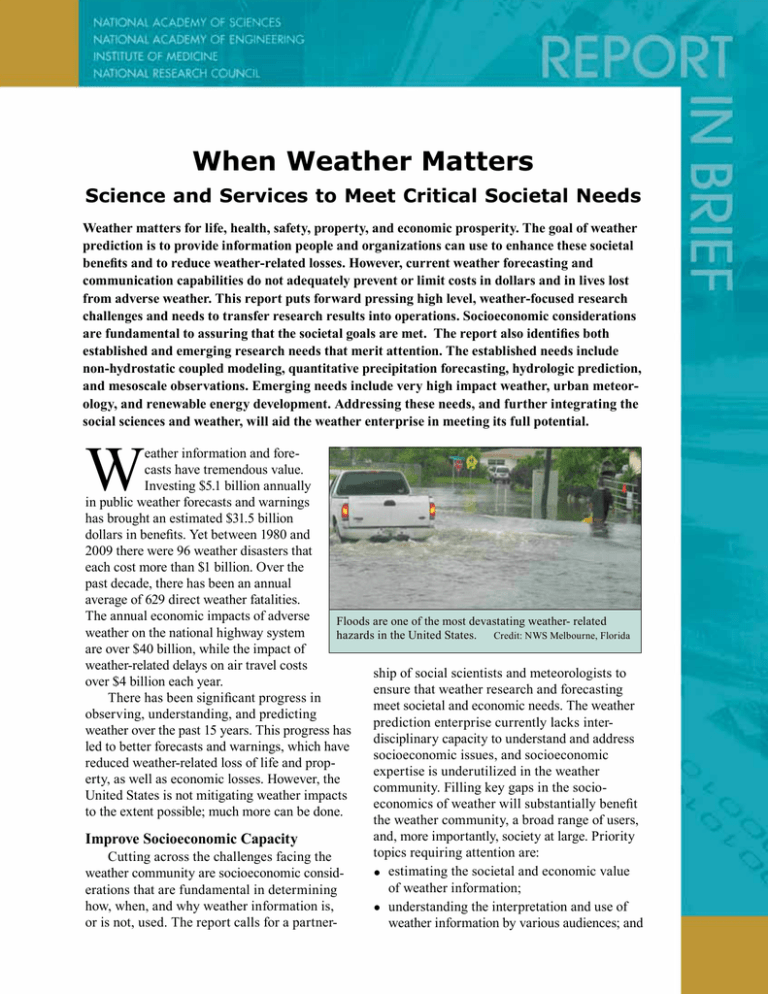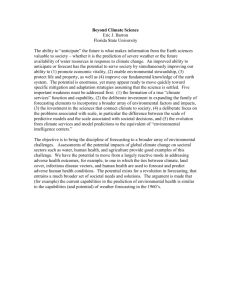When Weather Matters Science and Services to Meet Critical Societal Needs
advertisement

When Weather Matters Science and Services to Meet Critical Societal Needs Weather matters for life, health, safety, property, and economic prosperity. The goal of weather prediction is to provide information people and organizations can use to enhance these societal benefits and to reduce weather-related losses. However, current weather forecasting and communication capabilities do not adequately prevent or limit costs in dollars and in lives lost from adverse weather. This report puts forward pressing high level, weather-focused research challenges and needs to transfer research results into operations. Socioeconomic considerations are fundamental to assuring that the societal goals are met. The report also identifies both established and emerging research needs that merit attention. The established needs include ­non-hydrostatic coupled modeling, quantitative precipitation forecasting, hydrologic prediction, and mesoscale observations. Emerging needs include very high impact weather, urban meteor­ ology, and renewable energy development. Addressing these needs, and further integrating the social sciences and weather, will aid the weather enterprise in meeting its full potential. W eather information and fore­ casts have tremendous value. Investing $5.1 billion annually in public weather forecasts and warnings has brought an estimated $31.5 billion dollars in benefits. Yet between 1980 and 2009 there were 96 weather disasters that each cost more than $1 billion. Over the past decade, there has been an annual average of 629 direct weather fatalities. The annual economic impacts of adverse Floods are one of the most devastating weather- related weather on the national highway system hazards in the United States. Credit: NWS Melbourne, Florida are over $40 billion, while the impact of weather-related delays on air travel costs ship of social scientists and meteorologists to over $4 billion each year. ensure that weather research and forecasting There has been significant progress in meet societal and economic needs. The weather observing, understanding, and predicting prediction enterprise currently lacks inter­ weather over the past 15 years. This progress has disciplinary capacity to understand and address led to better forecasts and warnings, which have socioeconomic issues, and socio­economic reduced weather-related loss of life and prop­ expertise is underutilized in the weather erty, as well as economic losses. However, the community. Filling key gaps in the socio­ United States is not mitigating weather impacts economics of weather will substantially benefit to the extent possible; much more can be done. the weather community, a broad range of users, and, more importantly, society at large. Priority Improve Socioeconomic Capacity topics requiring attention are: Cutting across the challenges facing the weather community are socioeconomic consid­ • estimating the societal and economic value of weather information; erations that are fundamental in determining how, when, and why weather information is, • understanding the interpretation and use of or is not, used. The report calls for a partner­ weather information by various audiences; and • applying this knowledge to improve communi­ cation, use, and value of weather information. Continue Pursuing Established Research Needs There are multiple research needs that have been recognized for some time as important, yet still need attention from the weather community. Achieving these goals will require input from social scientists and will result in significant societal benefits. The report calls for the continued pursuit of these estab­ lished weather research and transitional needs: • development of global non-hydrostatic coupled models to meet the increasing demands for improved weather forecasts with extended timescales from hours to weeks; • explicit representation of deep convection in forecast models and use of sophisticated proba­ bilistic prediction techniques to improve quantitative precipitation forecasting; • improved hydrologic prediction skill through the support of a community-based coupled atmospheric-hydrologic modeling framework; and • expand observations by deploying a national network of profiling devices for mesoscale weather and chemical weather prediction purposes. Increase Attention to Emerging Issues Over the past decade or so, several research needs have been recognized as increasingly ­important. Understanding of these issues, and implementation of results, remains in the early stages. The report identifies these as emerging weather research and transitional needs, and encourages increased attention • Very high impact weather situations require the public and private weather sectors to expand their efforts to include both improved weather forecasts and explicit impact forecasts; • Meteorological services that focus on where people live, especially urban areas, require the creation of infrastructure, products, and services tailored to the special needs of cities; and • The effective design and operation of wind and solar renewable energy production facilities requires the development, evaluation, and imple­ mentation of improved and new atmospheric observing and modeling capabilities, and the decision support systems they enable. Conclusion As our Nation’s weather challenges have changed, so must our scientific research and opera­ tional priorities change. The various socioeconomic, established, and emerging issues identified in this report require increased attention. The weather community needs to establish and nurture effec­ tive partnerships across disciplines and sectors. This report is relevant to all parties in the weather enterprise: agency decision makers, policy makers, research scientists, private sector applications specialists, teachers, public and private user groups and organization, and the general public. Committee on Progress and Priorities of U.S. Weather Research and Research-To-Operations Activities: Walter F. Dabberdt (Chair), Vaisala, Inc.; Richard Carbone, National Center for Atmospheric Research, Boulder, Colorado; Shuyi S. Chen, University of Miami, Florida; Greg S. Forbes, The Weather Channel Inc.; Efi Foufoula-Georgiou, University of Minnesota, Minneapolis; Rebecca Morss, National Center for Atmospheric Research, Boulder, Colorado; John T. Snow, University of Oklahoma, Norman; Xubin Zeng, University of Arizona; Curtis Marshall (Senior Program Officer), Maggie Walser (Associate Program Officer), Toby Warden (Associate Program Officer), Lauren Brown (Research Associate); Janeise Sturdivant (Program Assistant), National Research Council. The National Academies appointed the above committee of experts to address the specific task supported by the National Aeronautics and Space Administration, the National Oceanic and Atmospheric Administration, and the National Science Foundation. The members volunteered their time for this activity; their report is peer-reviewed and the final product signed off by both the committee members and the National Academies. This report brief was prepared by the National Research Council based on the committee’s report. For more information, Board on Atmospheric Sciences and Climate at (202) 334-3512 or visit http://nationalacademies.org/ basc. Copies of When Weather Matters: Science and Services to Meet Critical Societal Needs are available from the National Academies Press, 500 Fifth Street, NW, Washington, D.C. 20001; (800) 624-6242; www.nap.edu. Permission granted to reproduce this brief in its entirety with no additions or alterations. Permission for images/figures must be obtained from their original source. © 2010 The National Academy of Sciences




